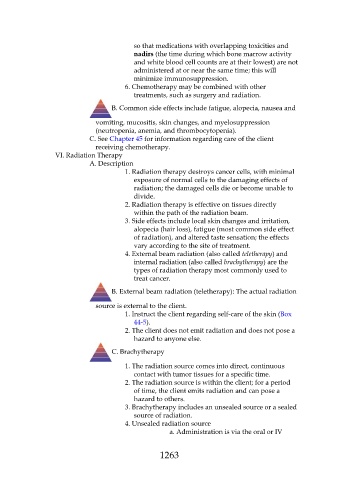Page 1263 - Saunders Comprehensive Review For NCLEX-RN
P. 1263
so that medications with overlapping toxicities and
nadirs (the time during which bone marrow activity
and white blood cell counts are at their lowest) are not
administered at or near the same time; this will
minimize immunosuppression.
6. Chemotherapy may be combined with other
treatments, such as surgery and radiation.
B. Common side effects include fatigue, alopecia, nausea and
vomiting, mucositis, skin changes, and myelosuppression
(neutropenia, anemia, and thrombocytopenia).
C. See Chapter 45 for information regarding care of the client
receiving chemotherapy.
VI. Radiation Therapy
A. Description
1. Radiation therapy destroys cancer cells, with minimal
exposure of normal cells to the damaging effects of
radiation; the damaged cells die or become unable to
divide.
2. Radiation therapy is effective on tissues directly
within the path of the radiation beam.
3. Side effects include local skin changes and irritation,
alopecia (hair loss), fatigue (most common side effect
of radiation), and altered taste sensation; the effects
vary according to the site of treatment.
4. External beam radiation (also called teletherapy) and
internal radiation (also called brachytherapy) are the
types of radiation therapy most commonly used to
treat cancer.
B. External beam radiation (teletherapy): The actual radiation
source is external to the client.
1. Instruct the client regarding self-care of the skin (Box
44-5).
2. The client does not emit radiation and does not pose a
hazard to anyone else.
C. Brachytherapy
1. The radiation source comes into direct, continuous
contact with tumor tissues for a specific time.
2. The radiation source is within the client; for a period
of time, the client emits radiation and can pose a
hazard to others.
3. Brachytherapy includes an unsealed source or a sealed
source of radiation.
4. Unsealed radiation source
a. Administration is via the oral or IV
1263

